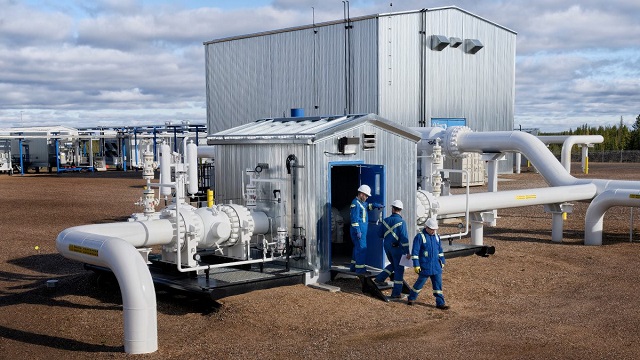Alberta
New $1 billion pipeline deal spreads Indigenous ownership through Alberta, B.C. and Saskatchewan

From the Canadian Energy Centre
By Will Gibson
‘We are writing the history of tomorrow today, not living the outcomes of our forefathers’
In a landmark agreement announced July 30, a consortium of up to 72 Indigenous communities in Alberta, British Columbia and Saskatchewan will buy a 5.34 per cent stake in TC Energy’s NGTL natural gas network.
The agreement is backed by a $1 billion loan guarantee from the Alberta Indigenous Opportunities Corporation (AIOC).
TC Energy’s sprawling NGTL network spans 25,000 kilometres and handles about 10 per cent of North America’s natural gas, connecting production in Alberta and British Columbia to domestic and export markets.
The loan guarantee has similarly impressive scope and size, quadrupling the AIOC’s previous largest financial commitment, a $250 million loan guarantee provided to 23 Indigenous communities in September 2022 to help purchase an 11.57 per cent stake in seven Enbridge oil sands pipelines in northern Alberta.
The deal will raise the AIOC’s support of Indigenous equity ownership in resource projects to over $1.68 billion since 2019.
“I’ve participated in three of these transactions, including the Enbridge loan guarantee, and you can see an evolution in the size and complexity of these agreements,” says Justin Bourque, founder and president of Âsokan Generational Developments, a consultancy that specializes in partnerships between Indigenous communities and industry.
“They are building on the good work from previous deals and it’s wonderful to see the AIOC expanding into neighbouring provinces, where these types of agreements will have significant benefits to the participating Nations in B.C. and Saskatchewan as well as Alberta.”

Âsokan Generational Developments president and founder Justin Bourque pictured on his trap line in northern Alberta with the Long Lake oil sands facility in the background. Photo for Canadian Energy Centre
The new agreement also demonstrates growing comfort among Indigenous communities, industry players and lenders as these equity arrangements become more commonplace, says Heather Exner-Pirot, director of energy, natural resources and environment at the Macdonald-Laurier Institute, an Ottawa-based think tank.
“There are some formidable challenges with trying to negotiate with multiple communities across different treaty areas and provinces, but this shows the confidence the Alberta government has in backstopping these bespoke deals with communities and companies when the merits of the project deserves it,” says Exner-Pirot, who also serves as a special advisor to the Business Council of Canada.
“It also demonstrates the confidence from the lenders in these equity deals for pipelines. And that confidence is well founded because these existing pipelines are a stable business that generate the revenues to pay back the loan as well as income for the communities to use as well.”
The announcement builds on momentum for Indigenous ownership of Canadian energy projects, including June’s announcement that the Haisla Nation and Pembina Pipeline Corporation will move ahead with the Cedar LNG project.
The floating LNG export facility on Canada’s west coast will be the world’s first with Indigenous majority ownership.
Bourque sees the agreements providing a framework for future partnerships between Indigenous communities, government and industry beyond equity ownership.
“This is an important stepping stone in our evolution and it’s exciting to see it continue through pursuing opportunities in energy development, decarbonization and energy transition projects,” Bourque says.
“We are writing the history of tomorrow today, not living the outcomes of our forefathers.”
Exner-Pirot also sees a bright future for collaborations between Indigenous communities and energy companies, in part because the federal, Saskatchewan and BC governments now also offer loan guarantee programs.
“These deals take months, if not years, to come together and what this shows is the AIOC, Indigenous communities and energy companies have found a template that works,” she says.
“The NGTL loan guarantee is the biggest but it won’t be the last one.”
Alberta
Alberta Provincial Police – New chief of Independent Agency Police Service

Sat Parhar has been appointed as the first chief of the Independent Agency Police Service, marking the next step toward a new municipal policing option.
The appointment of a new chief for the Independent Agency Police Service (IAPS) marks the next step in giving municipalities a new option for local policing and builds on the work already underway for the agency to assume the police-like duties currently carried out by the Alberta Sheriffs. The IAPS will empower municipalities to adopt strategies that effectively respond to their specific safety concerns, enhancing public safety across the province.
Chief Parhar brings more than 25 years of policing experience, including senior roles with the Calgary Police Service, most recently as deputy chief. His frontline policing experience and deep understanding of Alberta’s complex and diverse public safety landscape positions him to lead the agency as it takes shape and begins its work as a new municipal policing option, keeping communities safe.
Once operational, the agency will strengthen Alberta’s existing policing model and complement the province’s current police services, which includes the RCMP, Indigenous policing services and municipal police. It will help fill gaps and ensure law enforcement resources are deployed efficiently to meet Alberta’s evolving public safety needs and improve law enforcement response times, particularly in rural communities.
“Appointing Chief Sat Parhar is a key milestone in Alberta’s plan to give municipalities a real choice in how their communities are kept safe. This is about building a modern police service that reflects the priorities of Albertans, strengthens local decision-making, and ensures every corner of our province, especially rural areas, can count on responsive, effective law enforcement. With his decades of experience and deep understanding of Alberta’s policing landscape, he is the right leader to bring this vision to life.”
“This appointment signifies a significant step forward in our efforts to establish a more robust, community-focused policing model that is better equipped to meet the unique needs of our local residents. Under Chief Parhar’s visionary leadership, we are confident that we will develop a modern, efficient police service that not only enhances public safety but also aligns closely with the priorities and values of Albertans. His experience and commitment are vital in shaping an IAPS that is responsive, transparent, and dedicated to fostering trust and collaboration within the community, ultimately ensuring a safer and more connected society for all.”
Chief Parhar’s immediate priorities will be to hire an executive team and commence organizational planning such as developing key recruitment, training and other operational policies. Chief Parhar’s appointment is the first step of many to establishing the IAPS.
“It’s an honour to take on this role and help shape a modern police service built for Alberta. My focus from day one will be on setting high standards for professionalism, building strong relationships with our partners and ensuring this service reflects the needs and priorities of the communities we serve.”
The Independent Agency Police Service was formally created through regulation following the passing of Public Safety Statutes Amendment Act, 2024. The agency will operate as an independent Crown corporation, and will be renamed the Alberta Sheriffs Police Service, with its head office located in Calgary. The IAPS will be operationally independent from the provincial government with civilian oversight, consistent with all police services in Alberta.
“When it comes to policing, municipalities like ours deserve a choice – especially when the current system leaves us disadvantaged simply because of our size. We look forward to learning more about what that alternative will look like once an Alberta police agency is fully established and the options are clear. For us, this is about fairness, sustainability, and ensuring municipalities have access to policing solutions that reflect both their needs and their realities.”
Quick facts
- The regulation establishes the IAPS Provincial Corporation and its governance structure including board of directors, board of director powers, financial responsibilities and accountabilities.
Related news
- Expanding municipal police service options (April 7, 2024)
Alberta
Pierre Poilievre – Per Capita, Hardisty, Alberta Is the Most Important Little Town In Canada

From Pierre Poilievre
-

 Crime2 days ago
Crime2 days agoNational Health Care Fraud Takedown Results in 324 Defendants Charged in Connection with Over $14.6 Billion in Alleged Fraud
-

 Health2 days ago
Health2 days agoRFK Jr. Unloads Disturbing Vaccine Secrets on Tucker—And Surprises Everyone on Trump
-

 Business1 day ago
Business1 day agoElon Musk slams Trump’s ‘Big Beautiful Bill,’ calls for new political party
-

 Censorship Industrial Complex1 day ago
Censorship Industrial Complex1 day agoGlobal media alliance colluded with foreign nations to crush free speech in America: House report
-

 International21 hours ago
International21 hours agoCBS settles with Trump over doctored 60 Minutes Harris interview
-

 Business13 hours ago
Business13 hours agoLatest shakedown attempt by Canada Post underscores need for privatization
-

 Business13 hours ago
Business13 hours agoWhy it’s time to repeal the oil tanker ban on B.C.’s north coast
-

 International1 day ago
International1 day agoRFK Jr. tells Tucker how Big Pharma uses ‘perverse incentives’ to get vaccines approved









